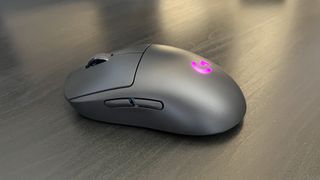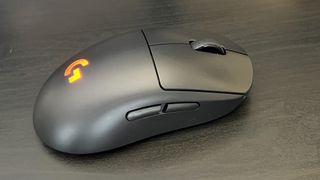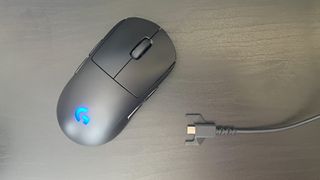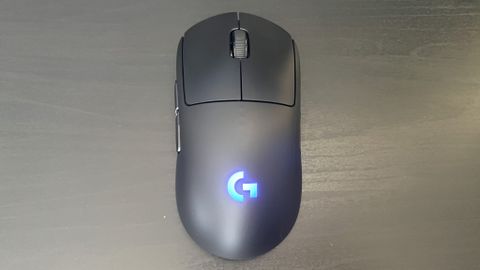GamesRadar+ Verdict
The Logitech G Pro Wireless is still one of the top performers on the market, holding its own against far more recent pointers thanks to excellent tracking, a comfortable design, and a range of extra customization features.
Pros
- +
Excellent tracking
- +
Soft, crisp clicks
- +
Ambidextrous design with swappable buttons
- +
Fantastic battery life
Cons
- -
Not an ergonomic right hand design
Why you can trust GamesRadar+
The Logitech G Pro Wireless isn't exactly a new face on the scene, but it does hold up remarkably well considering it was originally launched in 2018. That should put it behind the latest and greatest releases on the market, but with Logitech's HERO 25K sensor at the helm, a smooth ambidextrous design, and some excellent quality of life features, it's still a front runner among the best gaming mouse options available.
This isn't a cheap affair, though. The Logitech G Pro carries a $129.99 / £109.99 MSRP. However, that is a little cheaper than some of the best wireless gaming mouse options on the market - while still offering top-shelf performance. We put this golden oldie to the test to see just how well it holds up against today's competition.
Design
Price: $129.99 / £109.99
Form factor: Ambidextrous
DPI: 25,600
IPS: Up to 400
Switches: Omron mechanical
Connectivity: Wired / Wireless (2.4GHz)
Feet: PTFE
Weight: 80g
The Logitech G Pro Wireless would sit well on any desk. It holds an understated design, with an all-black matte plastic shell and a simple window of RGB running through the G logo at the base. This plastic material has been chosen to maintain that 80g weight, and while you're dropping any grippy texture running down each side, I never felt any slip from the softer material. By contrast, the smooth plastic can begin to feel clammy during longer sessions, especially if you're in a warmer climate.
You'll be able to use the G Pro as a right or left-handed gaming mouse, which means the overall shape is a little less ergonomic than you'd find on a slanted device like the Logitech G502 Lightspeed. However, the flatter top is still comfortable under a range of grip types, with a relatively low-profile hump nestling the back of the mouse nicely into the palm. I primarily used a palm and fingertip grip here and the G Pro Wireless felt tailor-made for both. The smaller hump may make claw grips a little less comfortable than purpose-built devices, but testing in this style didn't reveal any major discomfort over long periods of gameplay.

You'll find two side buttons along the left-hand side, and two slots for optional right-side buttons thanks to that ambidextrous design. It's worth noting that you can gear up fully with all four buttons at once, which is a nice touch. The underside of the device holds a power button, DPI shifter, and USB receiver slot.
Overall, the Logitech G Pro Wireless feels excellent under the hand, with a lightweight form factor, comfortable shape, and solid, durable build quality. Unfortunately, that kind of quality isn't quite translated over to the plastic cable, which can drag when plugged in. However, I did appreciate the supports on either side of the mini-USB connection to avoid damaging the port during movement.
Features
All in all, the Logitech G Pro Wireless features eight programmable buttons, capable of mapping up to 15 different functions (taking the G-Shift button layer into account as well). Considering this is such a streamlined, performance-focused pointer, that's an excellent result. I'm usually sacrificing macro commands and extra controls for the luxury of speed in a lightweight design, so being able to keep a solid range of function in this form was particularly impressive.
The G Hub software can be used to fully reprogram each button, while also setting RGB and the presets for your DPI shifter (in increments of 50 up to 25,600). There's also a particularly strong battery life working for you here. Logitech recommends around 45 hours with RGB on and 60 hours without, and during my testing I hit numbers that feel aligned with those expectations.

I ran the G Pro Wireless for a week off 50% charge, running through daily work and a few hours of play in the evenings, and only hit a warning light by Thursday. Even then, I was still rolling through until the next day before the flashing RGB suggested a power down was imminent - and I never experienced any stuttering while in this low battery state.
If you don't even want that level of charging on your mind, it's also worth noting that the Logitech G Pro Wireless is compatible with Logitech's PowerPlay charging mouse pad as well.
Performance

From its low click latency to its super-accurate tracking, everything about the Logitech G Pro's performance still holds up to this day. That's particularly impressive considering this is an older mouse by the current market's standards. Sure, it was originally released with a 16K sensor, but updates have brought that up to these lofty 25K heights and the accuracy is outstanding here. Flicking my way through Apex Legends matches was easy and snappy, with even minute gestures recorded and reported in an instant.
Both left and right click buttons are short and sweet, with a quieter actuation than something like the Razer Viper and a slightly softer landing position. They never felt mushed though - everything feels clean and precise. The lower weight compounds with this to provide an agile experience overall - I never felt any fatigue after throwing this pointer around a Halo Infinite Arena.
Side buttons are well placed for quick reactions, though I found the top button to be a little heavier on first use. It's situated slightly further forwards than that of the Viper V2 Pro I was using previously, so once I had readjusted that muscle memory I was back to reloading with ease.
Should you buy the Logitech G Pro Wireless?

If you're looking for a wireless gaming mouse with silky smooth tracking for fast-paced titles, the Logitech G Pro Wireless will absolutely fit the bill. More competitive players may prefer a pointer in the ultralight category, however. The Razer Viper V2 Pro is decidedly nippier and handles use while plugged in a lot better as well, all while weighing in at just 58g. You're only spending $20 more on this model over the Logitech's MSRP, though it's worth noting you're more likely to find the G Pro Wireless on sale these days.
If you don't want to step out of your Logitech setup, though, we'd recommend taking a look at the G Pro X Superlight. At 63g you're still shaving off some of that extra weight and picking up similar performance under the hood - though you do drop the two extra side buttons on the right.
How we tested the Logitech G Pro Wireless
I used the Logitech G Pro Wireless over the course of one week for all my daily work and evening play. I used Apex Legends, CS:GO, and Halo Infinite to push the Hero sensor and tracking to its limits, while also testing during everyday Planet Coaster sessions. You can find out more about how we test gaming mice and how we make all of our recommendations in the full GamesRadar+ Hardware Policy.
For more inspiration, take a look at the best Razer mouse options on the web. Or, if you're re-working your whole setup, take a look at the best gaming keyboards and best gaming monitors available now. We're also rounding up all the latest cheap gaming mouse deals.

Managing Editor of Hardware at GamesRadar+, I originally landed in hardware at our sister site TechRadar before moving over to GamesRadar. In between, I've written for Tom’s Guide, Wireframe, The Indie Game Website and That Video Game Blog, covering everything from the PS5 launch to the Apple Pencil. Now, i'm focused on Nintendo Switch, gaming laptops (and the keyboards, headsets and mice that come with them), PS5, and trying to find the perfect projector.

Helldivers 2's PSN mandate won't stop players in unsupported regions from playing the game, while devs look "for better options"

Manor Lords player complains about undead animals taking up space, dev pops up to say "I fixed it already – will be added to the next patch"

Lego Boarding the Tantive IV review: "The perfect mix"
